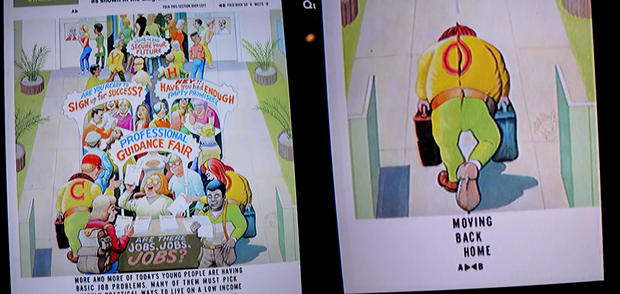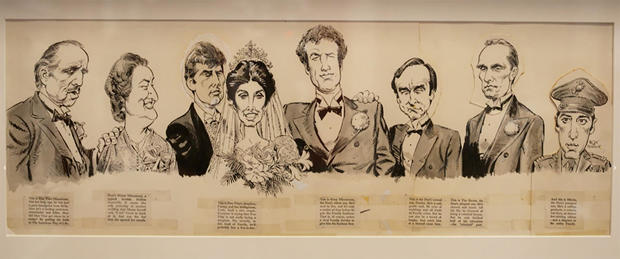
How Mad Magazine’s humor created a revolution
Nestled the rolling hills of rural Massachusetts. swathed by manicured grounds, sits the Norman Rockwell Museum. And there, side-by-side with the wholesome works of America’s most beloved illustrator, is the world’s dumbest cover boy: Alfred E. Neuman.
“It’s sacrilegious! It’s an outrage!” laughed political cartoonist Steve Brodner. “But I do think if Norman Rockwell were here, he’d laugh his head off. He’d think this was fantastic.”
These hallowed halls are now home to the world’s largest exhibit of artwork from Mad Magazine, co-curated by Brodner. “I was formed by Mad,” he said. “My idea of comedy, humor, irreverent drawing comes from this.”
CBS News
Mad began in 1952 as a comic book that made fun of other comic books. But if you came of age during Mad’s peak – the sixties, seventies and eighties – you know what it became: A hilarious guide to the hypocrisy of the authority figures in your life, whom Mad kept characterizing as idiots. “I know! Isn’t that marvelous?” said Brodner.
He died last year at 102.
In 1978 Jaffe told CBS’ “30 Minutes,” “People have been doing satire one way or another throughout the ages. The only difference is, most of them wound up in dungeons, and we wind up on the newsstand.”
Brodner called Jaffee one of the geniuses of Mad, who concocted the interior back page, which turned into a “fold-in.”
© and TM E.C. Publications, courtesy of DC
But one Mad artist gets a whole museum room: Mort Drucker, who died in 2020. “Everything is experimentation,” Drucker once said. “And that’s the fun of it all, once you get a handle on what a good artist is supposed to be and do.”
© and TM E.C. Publications, courtesy of DC
“He really loved people, and I think that’s why he was such a successful caricaturist,” said Mort Drucker’s daughter, Laurie Drucker Bachner. “Because he, like, inhaled the persona of somebody, and wanted them to be realized in the best way possible.”
Oddly enough, Drucker did not have professional training. “He did go to Parsons for three months, and they told him he really was ‘not cut out to be an artist,'” said his daughter. “He was pretty devastated, you know, ’cause he always thought of himself as an artist.”
Drucker went on to draw for Mad for over 50 years.
At its peak in 1974, Mad sold 2.1 million copies. It was wildly profitable, even though Bill Gaines (its publisher from the magazine’s founding until his death in 1992) refused to accept advertising. “This is just a thing with me: I’ve always been against ads,” Gaines told “30 Minutes.” “It’s a good thing to publish, if you can, without any outside help, so you’re not beholden to anybody.”
But eventually, readership began to decline. People have all kinds of theories as to why: magazines began dying off, the ‘usual gang of idiots’ began dying off, the internet happened.
And then, there was the ownership problem, according to Ficarra: “Bill sold it to a guy who owned another magazine that was losing money. They sold it to, I think, a holding company. We became part of Warner Publishing. And then, just as I was leaving, AT&T bought the company, really screwed it up (please don’t cut that out!), and sold it again now to Discovery.”
DeBartolo said, “For a very brief time, I think it was just a month, it was Smucker’s Jams and Jellies! We thought, ‘How did we get there?'”
Mad’s last regular issue came out in April 2018; the Mad exhibition runs through the end of October. But the Mad influence still runs strong, its impact acknowledged by “The Simpsons,” Weird All Yankovic, Stephen Colbert and Jon Stewart. Laurie Drucker Bachner said, had there been no Mad, “You think there would have been ‘SNL’? Or any of the standups?”
Brodner said, “Mad actually created a revolution in the United States. People are still saying, ‘I don’t believe that. I’m gonna investigate this and see what the truth of it is.’ And I think that’s what Mad is saying: Don’t buy the con, you know?”
For more info:
- Mad Magazine
- Exhibition: “What, Me Worry? The Art and Humor of Mad Magazine,” at the Norman Rockwell Museum, Stockbridge, Mass. (though October 27) | Exhibition magazine
- Cartoonist Steve Brodner
- MAD and all related elements © and TM E.C. Publications. Courtesy of DC
- Norman Rockwell images courtesy of Norman Rockwell Museum. © SEPS, Curtis Licensing and/or Norman Rockwell Family Agency
- Norman Rockwell Museum video footage © Norman Rockwell Museum; all rights reserved. Used with permission.
- Drone & aerial footage by Richard Sands & Terry Holland
Story produced by Robert Marston. Editor: George Pozderec.
David Pogue
Source: cbsnews.com


